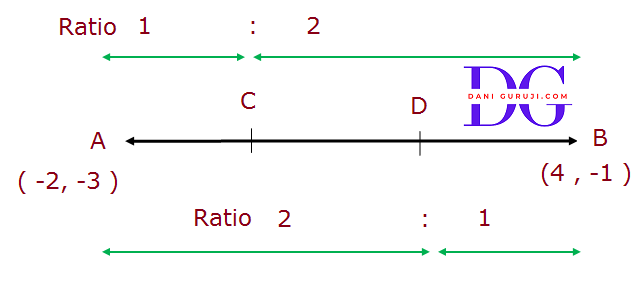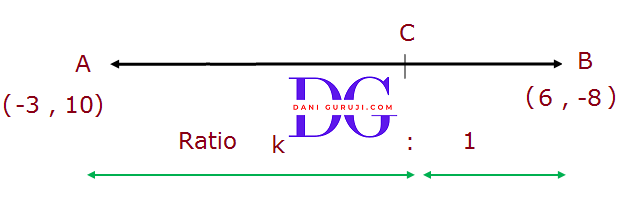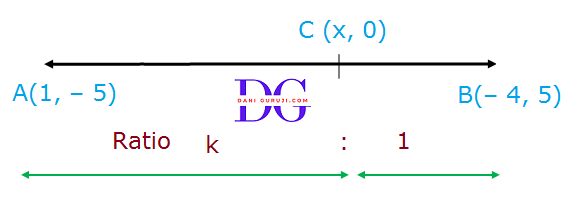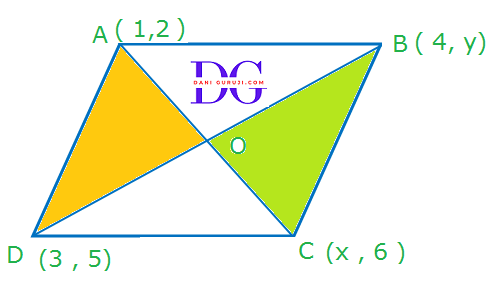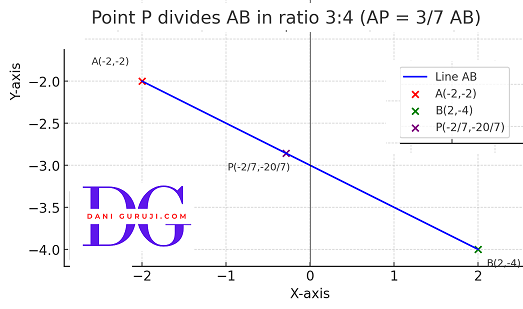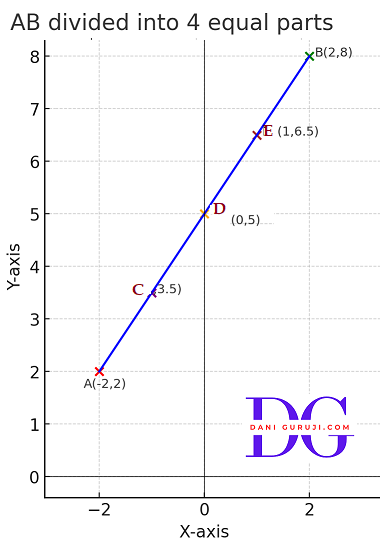Find the coordinates of the point which divides the join of (–1, 7) and (4, –3) in the ratio 2: 3.
Solution :
Let the given point A (–1, 7) and B(4, –3) are points that are divided in ratio 2: 3 and
Let the point P(x, y) which divides the line AB in given ratio then,
By Section Formula ,$ P(x, y) = [{{ m_1x_2 + m_2x_1 } \over {m_1 + m_2} } ,{{ m_1y_2 + m_2y_1 } \over {m_1 + m_2} }]$
Here, x and y coordinate of point A , x1 = -1 and y1 = 7
And, x and y coordinate of point B, x2 = 4 and y2 = -3
And, $ m_1 $ = 2, and $ m_2 $ = 3 .
Using Section Formula, we have :
$$ x = {{ m_1x_2 + m_2x_1 } \over {m_1 + m_2} } $$
$$ x = {{(2 × 4)+ (3 × (-1)) } \over {2 + 3} } $$
$$ x = {{8 -3 } \over {5} } $$
$$ x = {{5 } \over {5} } $$
$$ x = 1 $$
And Y :
$$ y = {{ m_1y_2 + m_2y_1 } \over {m_1 + m_2} } $$
$$ y = {{(2 × (-3))+ (3 × 7)} \over {2 + 3} } $$
$$ y = {{-6 + 21 } \over {5} } $$
$$ y = {{15 } \over {5} } $$
$$ y = 3 $$
Therefore, the co-ordinates of point P are (1,3)
Find the coordinates of the points of trisection of the line segment joining (4,–1) and (–2, –3).
Solution :
Let the given point be A (–2, –3) and B (4, –1) and
Let C and D be the points of trisection of the line segment joining the given points i.e., AC = CD = DB
The points of trisection means that the points which divide the line in three equal parts. From the figure C, and D are these two points.
(A) By observation , point C divides AB internally in the ratio 1:2 .
Hence, $ m_1 $ = 1, and $ m_2 $ = 2 .
Here, x and y coordinate of point A , x1 = -2 and y1 = -3
And, x and y coordinate of point B, x2 = 4 and y2 = -1
Using Section Formula, we have :
$$ x = {{ m_1x_2 + m_2x_1 } \over {m_1 + m_2} } $$
$$ x = {{(1 × 4)+ (2 × (-2)) } \over {1 + 2} } $$
$$ x = {{4 - 4 } \over {3} } $$
$$ x = {{0 } \over {3} } $$
$$ x = 0 $$
And Y :
$$ y = {{ m_1y_2 + m_2y_1 } \over {m_1 + m_2} } $$
$$ x = {{(1 × (-1))+ (2 × (-3)) } \over {1 + 2} } $$
$$ y = {{-1 - 6 } \over {3} } $$
$$ y = {{-7 } \over {3} } $$
Therefore, the co-ordinates of point C (x,y ) are $ (0, {-7 \over 3}) $
(B) By observation , point D divides AB internally in the ratio 2:1 .
Hence, $ m_1 $ = 2, and $ m_2 $ = 1 .
Using Section Formula, we have :
$$ x = {{ m_1x_2 + m_2x_1 } \over {m_1 + m_2} } $$
$$ x = {{(2 × 4)+ (1 × (-2)) } \over {2 + 1} } $$
$$ x = {{8 - 2 } \over {3} } $$
$$ x = {{6 } \over {3} } $$
$$ x = 2 $$
And Y :
$$ y = {{ m_1y_2 + m_2y_1 } \over {m_1 + m_2} } $$
$$ x = {{(2 × (-1))+ (1 × (-3)) } \over {1 + 1} } $$
$$ y = {{-2 - 3 } \over {3} } $$
$$ y = {{-5 } \over {3} } $$
Therefore, the co-ordinates of point D (x,y ) are $ (2, {-5 \over 3}) $
To conduct Sports Day activities, in your rectangular shaped school ground ABCD, lines have been drawn with chalk powder at a distance of 1m each. 100 flower pots have been placed at a distance of 1m from each other along AD, as shown in Figure. Niharika runs 1/4 th the distance AD on the 2nd line and posts a green flag. Preet runs 1/5th the distance AD on the eighth line and posts a red flag. What is the distance between both the flags? If Rashmi has to post a blue flag exactly halfway between the line segment joining the two flags, where should she post her flag.
Solution :
Given that, Lines are drawn at a distance of 1 meter each and 100 flower pots have been placed at a distance of 1 meter each along AD.
Thus, total distance along one line = 100 × 1m = 100 meter .
By observation, that Niharika posted the green flag at (1 /4) th of the distance of AD on the second line.
Thus, distance = 100 /4 = 25 meter
Therefore, the coordinates of this point G are (2,25).
By observation, that Preet posted the red flag at (1 /5) th of the distance of AD on the eighth line.
Thus, distance = 100 /5 = 20 meter
Therefore, the coordinates of this point R are (8,20).
(1)We need to find distance between G (2,25) and R (8,20)
We know that, in a plane distance between two given points GR = $\sqrt{ (x_2 - x_1)^2 + (y_2 - y_1)^2 }$
Here, x and y coordinate of point G , x1 = 2 and y1 = 25
And, x and y coordinate of point R, x2 = 8 and y2 = 20
Putting Values in distance formula :
$$\sqrt{ (8 - 2)^2 + (20 - 25)^2 }$$
$$\sqrt{ (6 ))^2 + (-5 )^2 }$$
$$⇒ \sqrt{ 36 + 25 }$$
$$⇒ \sqrt{ 61 }$$
$$ GR = \sqrt{ 61 } Meters $$
Distance between both flags = $ \sqrt{ 61 } $ Meters .
(B) Also it is given that Rashmi had to post blue flag exactly mid point between the line segment joining the two flags.
Let this point be B(x,y).Then,
By Mid-point Formula ,$ B(x, y) = [{{ x_2 + x_1 } \over {2} } ,{{ y_2 + y_1 } \over {2} } ]$
Here, $ m_1 $ = 1, and $ m_2 $ = 1 .
Here, x and y coordinate of point G , x1 = 2 and y1 = 25
And, x and y coordinate of point R, x2 = 8 and y2 = 20
Using Mid-point Formula, we have :
$$ x = {{ x_2 + x_1 } \over {2} } $$
$$ x = {{ 8 +2 } \over { 2} } $$
$$ x = {{10 } \over {2} } $$
$$ x = 5 $$
And Y :
$$ y = {{ y_2 + y_1 } \over {2} } $$
$$ y = {{20+ 25 } \over {2} } $$
$$ y = {{45 } \over {2} } $$
$$ y = {22.5 } $$
Hence, the co-ordinates of point B (x,y ) are (5, 22.5)
Therefore, Rashmi should post her Blue Flag at 22.5 m on the 5th line.
Find the ratio in which the line segment joining the points (– 3, 10) and (6, – 8) is divided by (– 1, 6).
Solution :
Let the given point be A (– 3, 10) and B (6, – 8) and C (– 1, 6) .
We need to find ratio between AC and CB
Let the ratio in which the line segment joining A (– 3, 10) and B (6, – 8) is divided by point C (– 1, 6) be k:1.
Hence, $ m_1 $ = k, and $ m_2 $ = 1 .
By Section Formula ,$ C(x, y) = [{{ m_1x_2 + m_2x_1 } \over {m_1 + m_2} } ,{{ m_1y_2 + m_2y_1 } \over {m_1 + m_2} }]$
Here, x and y coordinate of point A , x1 = -3 and y1 = 10
And, x and y coordinate of point B, x2 = 6 and y2 = -8
And, x and y coordinate of point C, x = -1 and y = 6
Using Section Formula, we have :
$$ x = {{ m_1x_2 + m_2x_1 } \over {m_1 + m_2} } $$
$$ -1 = {{(k × 6)+ (1 × (-3)) } \over {k + 1} } $$
$$ -1 = {{6k - 3 } \over {k + 1} } $$
$$ -1 × (k + 1) = {6k - 3 }$$
$$ -k - 1 = {6k - 3 }$$
$$ -k - 6k = - 3 + 1 $$
$$ -7k = -2 $$
$$ 7k = 2 $$
$$ k = {{2 } \over {7} } $$
Since, ratio is k : 1
Thus, after substituting the value of k, we have the required ratio
∴ (2/7) : 1
or
2 : 7
Therefore, the point C divides the line AB in the ratio 2:7
Find the ratio in which the line segment joining A(1, – 5) and B(– 4, 5) is divided by the x-axis. Also, find the coordinates of the point of division.
Solution :
Let the given point be A(1, – 5) and B(– 4, 5) .
Point C is on 'x' axis, hence it's 'y' co-ordinate is 0. So, it is of the form C (x,0) .
Now, We need to find ratio between AC and CB
Let the ratio in which the line segment joining A(1, – 5) and B(– 4, 5) is divided by point C (x, 0) be k:1.
Hence, $ m_1 $ = k, and $ m_2 $ = 1 .
Here, x and y coordinate of point A , x1 = 1 and y1 = -5
And, x and y coordinate of point B, x2 = -4 and y2 = 5
And, x and y coordinate of point C, x = x and y = 0
Using Section Formula, we have :
$$ y = {{ m_1y_2 + m_2y_1 } \over {m_1 + m_2} } $$
$$ 0 = {{(k × 5)+ (1 × (-5)) } \over {k + 1} } $$
$$ 0 = {{5k - 5 } \over {k + 1} } $$
$$ 0 × (k + 1) = {5k - 5 }$$
$$ 0 = {5k - 5 }$$
$$ 5 = 5k $$
$$ k = {5 \over 5 } $$
$$ k = 1 $$
Since, ratio is k : 1
Thus, after substituting the value of k, we have the required ratio
1 : 1
Now , We need to find X
Using Section Formula, we have :
$$ x = {{ m_1x_2 + m_2x_1 } \over {m_1 + m_2} } $$
$$ x = {{(1 × (-4))+ (1 × 1) } \over {1 + 1} } $$
$$ x = {{-4 + 1 } \over {2} } $$
$$ x = {{-3 } \over {2} } $$
Hence, the co-ordinates of point C (x,y ) are $ ( {-3 \over 2} , 0) $
If (1, 2), (4, y), (x, 6) and (3, 5) are the vertices of a parallelogram taken in order, find x and y.
Solution :
Let the given vertices of a parallelogram ABCD are A(1, 2), B(4, y), C(x, 6) and D(3, 5)
We know that diagonals of a parallelogram bisect each other .
Intersection point O of diagonal AC and BD also divides these diagonals.
Therefore, O is the mid-point of AC and BD.
(A) We need to find midpoint of AC
Let the ratio in which the line segment joining A(1, 2) and C(x, 6) is divided by point O (x, y) be 1:1.
Hence, $ m_1 $ = 1, and $ m_2 $ = 1 .
By Section Formula ,$ O(x, y) = [{{ m_1x_2 + m_2x_1 } \over {m_1 + m_2} } ,{{ m_1y_2 + m_2y_1 } \over {m_1 + m_2} }]$
Here, x and y coordinate of point A , x1 = 1 and y1 = 2
And, x and y coordinate of point C, x2 = x and y2 = 6
And, x and y coordinate of point O, x = x and y = y
Using Section Formula, we have :
$$ x = {{ m_1x_2 + m_2x_1 } \over {m_1 + m_2} } $$
$$ x = {{(1 × x)+ (1 × 1) } \over {1 + 1} } $$
$$ x = {{x + 1 } \over {2} } $$
And Y :
$$ y = {{ m_1y_2 + m_2y_1 } \over {m_1 + m_2} } $$
$$ y = {{(1 × 6)+ (1 × 2) } \over {1 + 1} } $$
$$ y = {{8 } \over {2} } $$
$$ y = {4 } $$
Hence, the co-ordinates of point O (x,y ) are $ ( {{x + 1 } \over {2}} , 4) $ ..... (1)
(B)Now, We need to find midpoint of BD
Let the ratio in which the line segment joining B(4, y) and D(3, 5) is divided by point O (x, y) be 1:1.
Hence, $ m_1 $ = 1, and $ m_2 $ = 1 .
By Section Formula ,$ O(x, y) = [{{ m_1x_2 + m_2x_1 } \over {m_1 + m_2} } ,{{ m_1y_2 + m_2y_1 } \over {m_1 + m_2} }]$
Here, x and y coordinate of point B , x1 = 4 and y1 = y
And, x and y coordinate of point D, x2 = 3 and y2 = 5
And, x and y coordinate of point O, x = x and y = y
Using Section Formula, we have :
$$ x = {{ m_1x_2 + m_2x_1 } \over {m_1 + m_2} } $$
$$ x = {{(1 × 3)+ (1 × 4) } \over {1 + 1} } $$
$$ x = {{7 } \over {2} } $$
And Y :
$$ y = {{ m_1y_2 + m_2y_1 } \over {m_1 + m_2} } $$
$$ y = {{(1 × 5)+ (1 × y) } \over {1 + 1} } $$
$$ y = {{(5 + y) } \over {2} } $$
Hence, the co-ordinates of point O (x,y ) are $ ( {{7 } \over {2} } ,{{(5 + y) } \over {2} }) $ ..... (2)
Since both the coordinates are of the same point O , thus from Equation 1 and 2
$$ ( {{(x + 1 ) } \over {2}} , 4) = ( {7 \over 2 } ,{{(5 + y) } \over {2} }) $$
Comparing x co-ordinate :
$$ {{(x + 1 ) } \over {2}} = {7 \over 2} $$
$$ {x + 1 } = {{7 × 2}\over 2} $$
$$ {x + 1 } = {14 \over 2} $$
$$ {x } = {7 - 1} $$
$$ {x } = 6 $$
Comparing y co-ordinate :
$$ 4 = {{(5 + y) } \over {2} } $$
$$ {4 × 2} = {(5 + y) } $$
$$ 8 - 5 = y $$
$$ 3 = y $$
$$ y = 3 $$
Hence, x = 6 and y = 3.
Find the coordinates of a point A, where AB is the diameter of a circle whose centre is (2, – 3) and B is (1, 4).
Solution :
Let the centre point C(2, – 3) will be the mid-point of the diameter AB of the circle.
Given, coordinates of centre and one end point of a diameter are C (2, –3) and B (1, 4)
Then, the coordinates of point A will be A(x, y) .
We know that C is the mid-point of AB , then
Let the ratio in which the line segment joining A(x, y) and B(1, 4) is divided by point C (2, –3) be 1:1.
Hence, $ m_1 $ = 1, and $ m_2 $ = 1 .
By Section Formula ,$ O(x, y) = [{{ m_1x_2 + m_2x_1 } \over {m_1 + m_2} } ,{{ m_1y_2 + m_2y_1 } \over {m_1 + m_2} }]$
Here, x and y coordinate of point A , x1 = x and y1 = y
And, x and y coordinate of point B, x2 = 1 and y2 = 4
And, x and y coordinate of point C, x = 2 and y = -3
Using Section Formula, we have :
$$ x = {{ m_1x_2 + m_2x_1 } \over {m_1 + m_2} } $$
$$ 2 = {{(1 × 1)+ (1 × x) } \over {1 + 1} } $$
$$ 2 = {{1 + x } \over {2} } $$
$$ 2 × 2 = 1 + x $$
$$ 4 - 1 = x $$
$$ x = 3 $$
And Y :
$$ y = {{ m_1y_2 + m_2y_1 } \over {m_1 + m_2} } $$
$$ -3 = {{(1 × 4)+ (1 × y) } \over {1 + 1} } $$
$$ -3 = {{4 + y } \over {2} } $$
$$ -3 × 2 = 4 + y $$
$$ -6 -4 = y $$
$$ y = -10 $$
Therefore, the coordinates of A are (3, – 10)
If A and B are (– 2, – 2) and (2, – 4), respectively, find the coordinates of P such that AP = $ {3 \over 7} $(AB) and P lies on the line segment AB.
Solution :
Let the given point be A (– 2, – 2) and B (2, – 4)
Let the co-ordinates of point P be P(x,y) .
And,It is given that AP = $ {3 \over 7} $AB .
$$ AP = {3 \over 7} (AP + PB) $$
$$ AP × 7 = 3 (AP + PB)$$
$$ 7AP = 3AP + 3PB $$
$$ 7AP - 3AP = 3PB $$
$$ 4AP = 3PB $$
$$ {AP \over PB} = {3 \over 4} $$
(A) By observation , point P divides AB internally in the ratio 3:4 .
Hence, $ m_1 $ = 3, and $ m_2 $ = 4 .
By Section Formula ,$ P(x, y) = [{{ m_1x_2 + m_2x_1 } \over {m_1 + m_2} } ,{{ m_1y_2 + m_2y_1 } \over {m_1 + m_2} }]$
Here, x and y coordinate of point A , x1 = -2 and y1 = -2
And, x and y coordinate of point B, x2 = 2 and y2 = -4
Using Section Formula, we have :
$$ x = {{ m_1x_2 + m_2x_1 } \over {m_1 + m_2} } $$
$$ x = {{(3 × 2)+ (4 × (-2)) } \over {3 + 4} } $$
$$ x = {{6 - 8 } \over {7} } $$
$$ x = {{-2 } \over {7} } $$
And Y :
$$ y = {{ m_1y_2 + m_2y_1 } \over {m_1 + m_2} } $$
$$ y = {{(3 × (-4))+ (4 × (-2)) } \over {3 + 4} } $$
$$ y = {{-12 - 8 } \over {7} } $$
$$ y = {{-20 } \over {7} } $$
Therefore, the co-ordinates of point P (x,y ) are $ ({-2 \over 7} , {-20 \over 7}) $
Find the coordinates of the points which divide the line segment joining A(– 2, 2) andB (2, 8) into four equal parts.
Solution :
Let the given point be A (–2, 2) and B (2, 8) and
Let C and D , E be the points of four section of the line segment joining the given points i.e., AC = CD = DE = EB
The points of four section means that the points which divide the line in four equal parts. From the figure C, and D and E are these three points.
(A) By observation , point D divides AB internally in the ratio 2:2 or 1 : 1
Hence, $ m_1 $ = 1, and $ m_2 $ = 1 .
By Section Formula ,$ D(x, y) = [{{ m_1x_2 + m_2x_1 } \over {m_1 + m_2} } ,{{ m_1y_2 + m_2y_1 } \over {m_1 + m_2} }]$
Here, x and y coordinate of point A , x1 = -2 and y1 = 2
And, x and y coordinate of point B, x2 = 2 and y2 = 8
Using Section Formula, we have :
$$ x = {{ m_1x_2 + m_2x_1 } \over {m_1 + m_2} } $$
$$ x = {{(1 × 2)+ (1 × (-2)) } \over {1 + 1} } $$
$$ x = {{2 - 2 } \over {2} } $$
$$ x = {{0 } \over {2} } $$
$$ x = 0 $$
And Y :
$$ y = {{ m_1y_2 + m_2y_1 } \over {m_1 + m_2} } $$
$$ x = {{(1 × 8)+ (1 × 2) } \over {1 + 1} } $$
$$ y = {{8 + 2 } \over {2} } $$
$$ y = {{10 } \over {2} } $$
$$ y = 5 $$
Therefore, the co-ordinates of point D (x,y ) are (0,5)
(B) Similarly By observation , point C divides AD internally in the ratio 1 : 1
Hence, $ m_1 $ = 1, and $ m_2 $ = 1 .
By Section Formula ,$ C(x, y) = [{{ m_1x_2 + m_2x_1 } \over {m_1 + m_2} } ,{{ m_1y_2 + m_2y_1 } \over {m_1 + m_2} }]$
Here, x and y coordinate of point A , x1 = -2 and y1 = 2
And, x and y coordinate of point D, x2 = 0 and y2 = 5
Using Section Formula, we have :
$$ x = {{ m_1x_2 + m_2x_1 } \over {m_1 + m_2} } $$
$$ x = {{(1 × 0)+ (1 × (-2)) } \over {1 + 1} } $$
$$ x = {{0 - 2 } \over {2} } $$
$$ x = {{-2 } \over {2} } $$
$$ x = -1 $$
And Y :
$$ y = {{ m_1y_2 + m_2y_1 } \over {m_1 + m_2} } $$
$$ x = {{(1 × 5)+ (1 × 2) } \over {1 + 1} } $$
$$ y = {{5 + 2 } \over {2} } $$
$$ y = {{7 } \over {2} } $$
Therefore, the co-ordinates of point C (x,y ) are (-1 ,${7 \over 2}$)
(C) Similarly By observation , point E divides DB internally in the ratio 1 : 1
Hence, $ m_1 $ = 1, and $ m_2 $ = 1 .
By Section Formula ,$ E(x, y) = [{{ m_1x_2 + m_2x_1 } \over {m_1 + m_2} } ,{{ m_1y_2 + m_2y_1 } \over {m_1 + m_2} }]$
Here, x and y coordinate of point D, x1 = 0 and y1 = 5
And, x and y coordinate of point B, x2 = 2 and y2 = 8
Using Section Formula, we have :
$$ x = {{ m_1x_2 + m_2x_1 } \over {m_1 + m_2} } $$
$$ x = {{(1 × 2)+ (1 × 0) } \over {1 + 1} } $$
$$ x = {{2 - 0 } \over {2} } $$
$$ x = {{2 } \over {2} } $$
$$ x = 1 $$
And Y :
$$ y = {{ m_1y_2 + m_2y_1 } \over {m_1 + m_2} } $$
$$ x = {{(1 × 8)+ (1 × 5) } \over {1 + 1} } $$
$$ y = {{8 + 5 } \over {2} } $$
$$ y = {13 \over 2} $$
Therefore, the co-ordinates of point E (x,y ) are ((1 ,${13 \over 2}$)
Find the area of a rhombus if its vertices are (3, 0), (4, 5), (-1, 4) and (-2, -1) taken in order..
Solution :
Let co-ordinates of rhombus be A(3, 0), B(4, 5), C(-1, 4) and D(-2, -1).
Calculation of distance between A and C
Here, x and y coordinate of point A , x1 = 3 and y1 = 0
And, x and y coordinate of point C, x2 = -1 and y2 = 4
( We know that, in a plane distance between two given points AC = $\sqrt{ (x_2 - x_1)^2 + (y_2 - y_1)^2 }$ )
Thus using distance formula, Putting Values in formula we have :
$$⇒ \sqrt{ (-1 - 3)^2 + (4 - 0)^2 }$$
$$⇒ \sqrt{ (-4 )^2 + (4 )^2 }$$
$$⇒ \sqrt{ 16 + 16 }$$
$$⇒ \sqrt{ 32 }$$
$$ AC = 4\sqrt{ 2 }$$
Calculation of distance between B and D
Here, x and y coordinate of point B , x1 = 4 and y1 = 5
And, x and y coordinate of point D, x2 = -2 and y2 = -1
Thus using distance formula, Putting Values in formula we have :
$$⇒ \sqrt{ (-2 - 4)^2 + (-1 - 5)^2 }$$
$$⇒ \sqrt{ (-6 )^2 + (-6 )^2 }$$
$$⇒ \sqrt{ 36 + 66 }$$
$$⇒ \sqrt{ 72 }$$
$$ BD = 6\sqrt{ 2 }$$
Area of rhombus (A) = 1/2 × Product of diagonals
$$⇒ {1\over 2}× 4\sqrt{ 2 } × 6\sqrt{ 2 }$$
$$⇒ {1\over 2}× 24 × 2 $$
$$⇒ {1\over 2}× 48$$
$$ = 24 $$
Hence, area of rhombus = 24 sq. units.
Syllabus for class 10
Advanced courses and exam preparation.
Previous Year Paper
Advanced courses and exam preparation.
Mock Test
Explore programming, data science, and AI.
